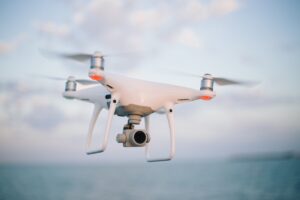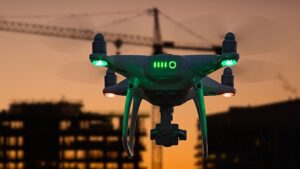Advancements in technology have led to a paradigm shift in the field of aviation, particularly in the domain of drones. The evolution of autonomous drones marks a significant milestone in this journey. Initially, drones were predominantly operated through remote piloting, wherein human operators controlled their flight paths and maneuvers from a distance. This method required skilled pilots and was limited in its capabilities, as drones could only execute tasks within the operator’s line of sight.
If you are a big enthusiast of autonomous drones, you can even purchase men’s t-shirts that have depictions of them.
With the advent of sophisticated sensors and communication technologies, remote piloting evolved to encompass longer ranges and more complex missions. Drones equipped with advanced cameras and GPS systems enable operators to conduct aerial surveys, monitor infrastructure, and even assist in search and rescue operations. However, the reliance on human intervention remained a bottleneck, as it constrained the scalability and efficiency of drone applications.
As industries sought to optimize operational workflows and minimize human error, the demand for autonomous drones surged. These unmanned aerial vehicles (UAVs) are equipped with artificial intelligence (AI) algorithms that enable them to perceive their environment, make decisions autonomously, and adapt to dynamic situations in real time. This transformative shift from remote piloting to AI navigation has unlocked a new era of possibilities in aerial robotics, revolutionizing industries ranging from agriculture and construction to logistics and emergency response.
Just as drones have evolved to navigate autonomously, the best beauty salon in Toronto has adapted cutting-edge technologies to elevate their services.
The Emergence of AI Navigation

AI navigation represents a leap forward in the evolution of autonomous drones, empowering them with unparalleled capabilities in perception, cognition, and decision-making. Unlike traditional remote piloting methods, which rely heavily on human input and manual control, AI-driven drones possess the intelligence to interpret sensory data, analyze situational contexts, and execute tasks with precision and efficiency. This transformative technology is poised to reshape various sectors, offering unprecedented opportunities for innovation and efficiency gains.
At the heart of AI navigation lies the integration of cutting-edge technologies such as computer vision, machine learning, and neural networks. These systems enable drones to perceive and understand their surroundings, identify obstacles, and navigate complex environments with ease. By leveraging advanced algorithms and sensor fusion techniques, autonomous drones can adapt to changing conditions, avoid collisions, and optimize their flight paths to achieve mission objectives effectively.
Piloting a drone is even more fun after eating the best milk chocolate edibles.
Moreover, AI navigation facilitates seamless coordination and collaboration among fleets of drones, enabling swarm intelligence for enhanced performance and scalability. This collective behavior allows multiple UAVs to collaborate in real-time, distributing tasks, sharing information, and accomplishing complex missions that would be impractical or impossible for individual drones to undertake alone. As a result, AI-driven navigation systems are revolutionizing industries ranging from agriculture and environmental monitoring to disaster response and urban planning.
Challenges and Future Directions
While the evolution of autonomous drones has unlocked tremendous potential, it also poses several challenges and considerations for researchers, engineers, and policymakers. One of the primary concerns is the ethical and regulatory implications of AI-driven systems, particularly regarding privacy, safety, and accountability. As drones become increasingly autonomous and ubiquitous, ensuring responsible and ethical deployment is paramount to mitigate risks and foster public trust. Experts working at pest control in Reno remark that in the near future, there might be land drones that can detect and eliminate specific types of pests.
Furthermore, the complexity of AI navigation algorithms necessitates robust testing, validation, and certification processes to guarantee reliability and safety in real-world scenarios. Addressing issues such as system robustness, cybersecurity vulnerabilities, and human-machine interaction will be critical to fostering widespread adoption and integration of autonomous drone technologies across diverse applications.
The Integration of Drones in Modern Society

The integration of drones in modern society has been nothing short of revolutionary, impacting various sectors from agriculture to filmmaking. One of the key areas where drones have made significant strides is in search and rescue operations. Equipped with high-resolution cameras and thermal imaging technology, drones have proven invaluable in locating missing persons in vast or inaccessible terrain. In disaster-stricken areas, drones provide real-time aerial views, aiding emergency responders in assessing the situation and planning their intervention strategies effectively.
Much like the advanced technology guiding drones from remote piloting to AI navigation, commercial plumbing services in Deerfield Beach showcase a progression from traditional methods to cutting-edge solutions.
Moreover, drones have transformed the way we approach environmental conservation efforts. Conservationists utilize drones to monitor wildlife populations, track illegal poaching activities, and assess habitat changes over time. By gathering data from above, drones enable scientists to study ecosystems in ways previously unattainable. Additionally, in agriculture, drones equipped with multispectral cameras can analyze crop health, detect pest infestations, and optimize irrigation patterns, leading to increased yields and reduced environmental impact.
Furthermore, drones have revolutionized the logistics and transportation industry by offering faster and more cost-effective delivery solutions. Companies like Amazon and UPS are exploring the use of drones for last-mile delivery, aiming to reduce delivery times and congestion on roads. In urban areas, drones could potentially alleviate traffic congestion by transporting small packages directly to consumers’ doorsteps. This shift towards drone delivery services not only enhances efficiency but also opens up new avenues for businesses to reach customers in remote or hard-to-access areas.
Much like the intricate technological advancements that enable drones to navigate autonomously, the design and construction of iron front doors have evolved to combine aesthetics with robust security features.
Challenges and Ethical Considerations
Despite the numerous benefits that drones bring, their widespread adoption also presents several challenges and ethical considerations. One of the primary concerns revolves around privacy rights and surveillance issues. As drones become more advanced and affordable, there is a growing risk of unauthorized surveillance and invasion of privacy. Striking a balance between leveraging drone technology for public safety and protecting individuals’ privacy rights remains a pressing challenge for policymakers and regulatory bodies worldwide.
Another significant challenge is the potential for misuse of drones by malicious actors. With their ability to carry payloads and cover long distances, drones pose security threats ranging from unauthorized surveillance to weaponization. Addressing these security concerns requires the development of robust counter-drone technologies and regulations to prevent drone-related incidents and mitigate their impact on public safety.
Many people who were under HRT therapy in Nolensville TN remark that they had fun manually piloting a drone around outside to pass the time while under therapy.
Moreover, the integration of drones into existing airspace systems raises complex regulatory issues and airspace management challenges. Coordinating the safe and efficient operation of drones alongside manned aircraft requires the implementation of strict airspace regulations and the development of sophisticated traffic management systems. Additionally, ensuring the reliability and cybersecurity of drone communication networks is essential to safeguard against potential cyber threats and airspace disruptions.
The Advancement of Drone Regulation and Policy
As the adoption of drones continues to accelerate, there is a pressing need for robust regulation and policy frameworks to govern their safe and responsible use. Regulatory bodies and governments worldwide are grappling with the challenge of striking a balance between fostering innovation and ensuring public safety. One approach gaining traction is the implementation of drone registration and licensing requirements, which help track and monitor drone ownership and usage. By mandating registration, authorities can hold drone operators accountable for their actions and mitigate the risks associated with irresponsible drone flying.
You can find autonomous drones for purchase online with a cheap price range, being almost as affordable as the highest quality personalized robes for women.
Moreover, the establishment of no-fly zones and restricted airspace areas is crucial for safeguarding sensitive locations such as airports, government buildings, and public events from unauthorized drone incursions. Through geofencing technology and airspace management systems, drone manufacturers and regulatory bodies can enforce airspace restrictions and prevent drones from entering prohibited areas. Additionally, educational initiatives and public awareness campaigns play a vital role in promoting safe and responsible drone operation among recreational and commercial users alike.
Furthermore, international collaboration and standardization efforts are essential for harmonizing drone regulations across borders and facilitating seamless operations in global airspace. Organizations such as the International Civil Aviation Organization (ICAO) are working to develop uniform standards and guidelines for drone operations, enabling interoperability between different regulatory regimes and enhancing the safety and efficiency of international drone flights.
Much like the evolution of drone technology, where autonomy enhances efficiency, millimeter wave circulators play a crucial role in ensuring the seamless flow of signals in electronic devices.
The Rise of Urban Air Mobility

One of the most promising developments in the drone industry is the rise of urban air mobility (UAM), which envisions a future where drones and electric vertical takeoff and landing (eVTOL) aircraft provide on-demand aerial transportation within urban areas. UAM promises to revolutionize urban mobility by alleviating traffic congestion, reducing carbon emissions, and enhancing connectivity between urban centers and surrounding suburbs. Companies like Uber, Volocopter, and Joby Aviation are pioneering the development of eVTOL aircraft and UAM infrastructure, aiming to bring aerial ridesharing services to fruition in the coming years.
Moreover, the integration of UAM into existing transportation networks requires collaboration between governments, regulatory bodies, and industry stakeholders to address airspace management, infrastructure development, and safety certification challenges. By establishing dedicated UAM corridors and vertiports equipped with charging infrastructure and ground support services, cities can create a conducive environment for the deployment of eVTOL aircraft and enable seamless integration with existing transportation modes. Just as autonomous drones represent a breakthrough in technology, offering new perspectives and capabilities, stem cell treatment for autism showcases a promising avenue for transforming the landscape of neurodevelopmental therapies.
Additionally, UAM holds the potential to revolutionize emergency medical services by enabling faster and more efficient transportation of patients and medical supplies in urban environments. With eVTOL ambulances and delivery drones, emergency responders can bypass traffic congestion and deliver life-saving interventions to those in need more rapidly than traditional ground-based ambulances. Moreover, UAM can facilitate the rapid transport of organs for transplantation, reducing wait times and improving patient outcomes in critical medical situations.
Conclusion
In conclusion, the evolution of autonomous drones and the rise of urban air mobility represent transformative trends that are reshaping the future of transportation, logistics, and public services. From enhancing search and rescue operations to revolutionizing last-mile delivery and aerial transportation, drones are poised to play a central role in addressing societal challenges and advancing human progress. However, realizing the full potential of drones and UAM requires concerted efforts from governments, regulatory bodies, industry stakeholders, and the public to address regulatory, safety, and infrastructure considerations. By fostering innovation, collaboration, and responsible stewardship of aerial technology, we can harness the power of drones to create a safer, more sustainable, and more connected world for future generations.
Much like how autonomous drones navigate and adapt to their surroundings, patio misting systems dynamically adjust to changing weather conditions, providing optimal cooling for outdoor spaces.